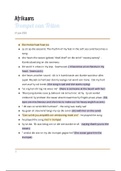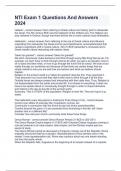Samenvatting
Summary >100 Theoretical Practice Questions IRM
- Vak
- Instelling
>100 Theoretical Practice Questions IRM, including theoretical Exam questions from this year's exam.
[Meer zien]Voorbeeld 2 van de 9 pagina's
Voorbeeld 2 van de 9 pagina's
Enkele voorbeelden uit deze set oefenvragen
1.
What are the assumptions of ANOVA
Antwoord: (1) Check if the observations are independent (2) Check if homoscedasticity is met. This is done by checking if the Levene\'s test is > 0.0* (3) Check if the dependent variable is normally distributed** * if Homoscedasticity is not met check (1) if the treatment groups are similar or (2) transform the DV with a logarithm (3) adjust the cut off ** If normalitaty is not met, check (1) if the sample size if big enough (30 ) or transform the DV so it more symmetric.
2.
What the assumptions of Factor Analysis
Antwoord: For factor analysis, multicollinearity is required. This can be checked by three ways: (1) Check the pearson R collinearity matrix and check if sufficient number has a higher correlation then 0.3 (2) Bartletts\'s test of spericity; Check if the significance level is < 0.05 (3) KMO/MSA: test if the MSA value is above 0.5* *Method 2 and 3 results can be find in the same table
3.
What are the assumptions of Cluster Analysis?
Antwoord: No hard statistical assumptions, but to subjective ones to keep in mind: (1) Representativeness (2) Multicollinearity: An overlap between variables is not per se an issue. Keep in mind that if you put both variables in the analysis, these variables will get more magnitude with them.
4.
What are the assumptions of Logistic Regression
Antwoord: (1) Dependent / outcome variable has only two groups (2) Robust to deviations from multivariate normality and homoscedasticity (2) No high correlations between independent variables (3) The outcome is a probability and must lie between zero and one
5.
What are the assumptions of Conjoint Analysis
Antwoord: (1) Check overfitting: Respondents only give a few answers per case and therefore it\'s hard to get real parameters (2) Garbage in Garbage out (GIGO) If data are badly collected, the results won\'t matter to.
6.
What are the assumptions of MDS
Antwoord: (1) Metric vs Non-metric MDS (2) Homogeneity: dimensionality, time, importance?* * If you make map at one point of time, it may be very different some time later.

Studenten hebben al meer dan 850.000 samenvattingen beoordeeld. Zo weet jij zeker dat je de beste keuze maakt!

Geen gedoe — betaal gewoon eenmalig met iDeal, creditcard of je Stuvia-tegoed en je bent klaar. Geen abonnement nodig.

Studenten maken samenvattingen voor studenten. Dat betekent: actuele inhoud waar jij écht wat aan hebt. Geen overbodige details!
Je krijgt een PDF, die direct beschikbaar is na je aankoop. Het gekochte document is altijd, overal en oneindig toegankelijk via je profiel.
Onze tevredenheidsgarantie zorgt ervoor dat je altijd een studiedocument vindt dat goed bij je past. Je vult een formulier in en onze klantenservice regelt de rest.
Stuvia is een marktplaats, je koop dit document dus niet van ons, maar van verkoper Elinevandeven. Stuvia faciliteert de betaling aan de verkoper.
Nee, je koopt alleen deze samenvatting voor $6.13. Je zit daarna nergens aan vast.
4,6 sterren op Google & Trustpilot (+1000 reviews)
Afgelopen 30 dagen zijn er 65040 samenvattingen verkocht
Opgericht in 2010, al 15 jaar dé plek om samenvattingen te kopen






